

| Cotswold Scale Masters 2001 |
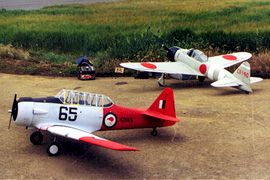 Sunday
8th of July was at least dry, after a week of torrential downpours and
thunderstorms. However, the wind was gusting between 10 and 15 mph as
Duncan Hutson, Contest Director for the day, called together the eleven
entrants for pilots briefing.
Sunday
8th of July was at least dry, after a week of torrential downpours and
thunderstorms. However, the wind was gusting between 10 and 15 mph as
Duncan Hutson, Contest Director for the day, called together the eleven
entrants for pilots briefing.
Due to the disappointing number of entries, Duncan had to abandon plans to run a Designer Scale competition in parallel with the main event. The main event was, Duncan informed us, to be run on BMFA guidelines with 1/3rd of the points awarded for static judging will the other 2/3rds going on the flying marks.
Flyers had to complete the compulsory manoeuvres of take off, straight & level flight, a figure of eight and an approach & landing, the descending circle manoeuvre having been dropped. To complete their flights pilots had to also fly five optional manoeuvres.
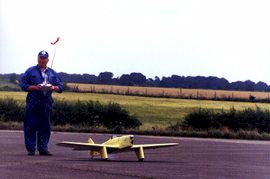 First
Up!
First
Up!
First up was John Thomas of Swansea. John usually flies a ¼ scale
Tiger Moth from the Duncan Hutson Models stable. But on leaving home and
seeing the conditions John opted to bring along his Miles Sparrowhawk.
This aircraft, he felt, would better handle the conditions of the day.
The model is ¼ scale with a wingspan of 84". Built from a Phillip Kent plan, the Laser 150 powered model is covered in 1/64th ply then finally covered with tissue to give the all metal skinned effect of the 1935 King's Cup competitor on which this model is based.
The Sparrowhawk is only in it's second year of competition having had only fifteen to twenty flights to date. John was a little disappointed with his static score, the judges felt that there wasn't enough colour/paint detail on his model.
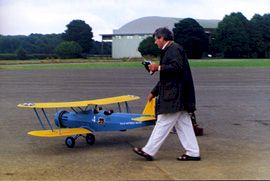 Great
Authority
Great
Authority
Martin Fardell was next to fly. A stalwart of many scale events, Martin
is currently flying a Douglas 0-38. The original Douglas 0-38 was derived
from the 0-2 that won the important Air Service Observation Plane competition
of 1924. The 0-38 was powered by a Pratt & Whitney Hornet engine and
served right up to the outbreak of the Second World War. Martin's model
is built to 1:4.8 scale, and has a wingspan of 100" The aircraft
flew around the sky with great authority and in a most realistic way,
powered by Laser 150. The only trouble Martin encountered was when he
tried to reproduce a 'Lazy 8' as one of his optional manoeuvres. The Douglas
not quiet having enough air speed to get through the downwind section
of the manoeuvre. However, the model did gain Martin one of the top flying
marks for the day.
 Jeff
Hartnoll, also from Swansea had brought along his Vought OS 2U Kingfisher.
Powered by a Laser 300V and built to 1/5th scale, this model is still
only in it's second year of competition, having debuted at last year's
'Nationals'. Built from a Brian Taylor plan, Jeff scaled it up by 50%.
He also produced the fibre glass cowlings and covered the model with tissue.
Finally he painted the Kingfisher with Humbrol enamels. Although only
producing an average score in the static judging circle, Jeff put in two
excellent flights that would, by the end of the day gain him second place.
Jeff and fellow Swansea compatriot John Thomas, were encouraging and helping
each other all day. A reflection on the friendly atmosphere at scale events!
Jeff
Hartnoll, also from Swansea had brought along his Vought OS 2U Kingfisher.
Powered by a Laser 300V and built to 1/5th scale, this model is still
only in it's second year of competition, having debuted at last year's
'Nationals'. Built from a Brian Taylor plan, Jeff scaled it up by 50%.
He also produced the fibre glass cowlings and covered the model with tissue.
Finally he painted the Kingfisher with Humbrol enamels. Although only
producing an average score in the static judging circle, Jeff put in two
excellent flights that would, by the end of the day gain him second place.
Jeff and fellow Swansea compatriot John Thomas, were encouraging and helping
each other all day. A reflection on the friendly atmosphere at scale events!
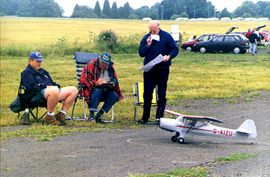 First
Event
First
Event
Competing in his very first scale event Richard Hawke entered no less
than two scale models! The first was a highly detailed Auster J1 Autocrat.
Built to Richard's own design, the 1/5th scale Autocrat weighed in at 8lbs and is powered by a Laser 80, using Futaba radio gear. The judges felt that the model was finished to a very high standard and this was reflected in the static marks awarded for the Autocrat.
Richard's second model was of the prototype Spitfire. The prototype fighter,
serial number K5054, was completed at Supermarine's Woolston works in
Southhampton, at the end of February 1936. It made it's maiden flight
from nearby Eastleigh Aerodrome in the hands of 'Mutt' Summers early on
the morning of  March
5th, watched by designer R.J. Mitchell and a number of company directors
and staff. The prototype underwent Service trials at Martlesham Heath
during April, and early the following month it was officially named the
Spitfire.
March
5th, watched by designer R.J. Mitchell and a number of company directors
and staff. The prototype underwent Service trials at Martlesham Heath
during April, and early the following month it was officially named the
Spitfire.
Again an own design by Richard, his Spitfire has a wingspan of 74", and is built to 1/6 scale. Richard uses Skyleader radio for this model and it weighs 14lbs, powered by a Laser 100. Richard was burning the midnight oil the night before, preparing the wide bladed scale prop ready for static judging. And very effective it looked too.
Richard again scored good static marks with the Spitfire, but due to the windy conditions, opted to fly each model only once. This decision meant that Richard would loose any second round flight points, all of which made up the final score. In spite of this Richard scored well in his debut competition. Look out for Richard at future events.
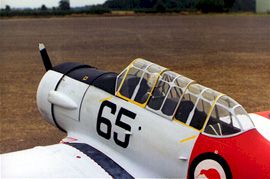 No
Response
No
Response
Immense disappointment befell Brian Wood and his Harvard. After experiencing
undercarriage problems during his morning flight, Brian under took some
remedial work including taking the wing off during the lunchtime break.
During the take off phase of his second round flight Brian had no aileron
response and the model crashed in to grass at the edge of the runway.
Competitors and judges speculated that Brian may have reversed or even
not reconnected the ailerons during his repairs. A great pity as the Harvard
was lying third after static judging.
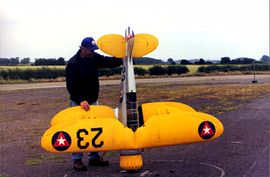 How
The Cuban 8 Was Invented
How
The Cuban 8 Was Invented
One of the larger models on show was the Waco built by Richard Crapp.
Built to ¼ scale Richard's model has a span of 103". The Laser
300V powered Waco was based on a plan from SIG's retired Chief Designer
Claude McColough. Richard had an interesting tale to tell about one of
the Waco's more famous pilots, Colonel Len Povey.
During the year of 1936, Len Povey was performing aerobatics at the "All American Show" at Miami, Florida and by accident invented a new revolutionary and exciting manoeuvre.
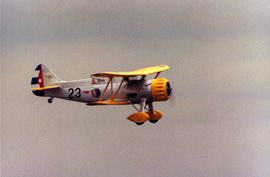 Povey
was going to make as an extra manoeuvre three aileron rolls in the top
of a loop. Realising that in the top of the loop he had 140 mph, too much
speed to perform the loops he decided to continue the loop and immediately
a half roll and repeated the manoeuvre in other to make a flat "8".
Upon landing, James Doolitle (later a General of great fame on account
of the Tokyo Raid) who was one of the judges questioned Povey. Asked if
that was his extra manoeuvre, to which Povey replied, that it was. When
asked about the name of such manoeuvre, Povey casually replied "a
Cuban 8". This manoeuvre became one of the most important manoeuvres
of co-ordination for future pilots.
Povey
was going to make as an extra manoeuvre three aileron rolls in the top
of a loop. Realising that in the top of the loop he had 140 mph, too much
speed to perform the loops he decided to continue the loop and immediately
a half roll and repeated the manoeuvre in other to make a flat "8".
Upon landing, James Doolitle (later a General of great fame on account
of the Tokyo Raid) who was one of the judges questioned Povey. Asked if
that was his extra manoeuvre, to which Povey replied, that it was. When
asked about the name of such manoeuvre, Povey casually replied "a
Cuban 8". This manoeuvre became one of the most important manoeuvres
of co-ordination for future pilots.
Richard's model gained second place in the static judging and during its two flights handled the gusty conditions with easy. With his second flight score improving on his first, Richard was unlucky to be pipped into third place.
 The
Real Thing
The
Real Thing
Flying into a very creditable 6th place overall, was Chris Harrison's
Mitsubishi Zero. Scoring well, the Zero was placed 4th by the static judges.
The model with a span of 96" looked every each the real thing as Chris
brought it in for a low pass (straight & level). Built from a Graham
Hughes plan, the Super Tigre 3000 powered model is controlled by Futaba
radio gear and at 1/5 scale, weighs 20lbs.
The Star Of The Show
The star of the show was, not suprisingly, Brian Taylor's Boeing PT17
Stearman. This model debuted at the Woodvale show last year, winning that
event and a few weeks later it was winning again, this time at the 'Nationals'.
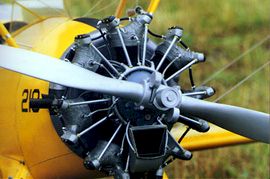 Brian's
model has a wingspan of 76" and comes in at a fraction under 1/5th
scale. The scale was determined by the size of Dubro wheels that were
available! The Stearman weighs in at 15 1/2 lbs. and is powered by a Laser
150 four stroke engine turning a 16 x 8 APC prop. The detail and level
of workmanship is something to behold! The model is of a balsa and ply
construction featuring working main undercarriage oleos, GRP front cowlings
and an immaculately modelled dummy engine.
Brian's
model has a wingspan of 76" and comes in at a fraction under 1/5th
scale. The scale was determined by the size of Dubro wheels that were
available! The Stearman weighs in at 15 1/2 lbs. and is powered by a Laser
150 four stroke engine turning a 16 x 8 APC prop. The detail and level
of workmanship is something to behold! The model is of a balsa and ply
construction featuring working main undercarriage oleos, GRP front cowlings
and an immaculately modelled dummy engine.
Brian did however, have a 'moment' during his second round flight, when one of his optional manoeuvres, a reversal, went wrong. Brian decided to try and roll in the opposite direction his normal way! The Stearman still took top marks in both flying rounds as well as top marks in the static judging ring.
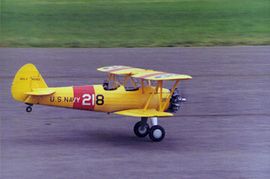 So,
when the points had been ably calculated, by Duncan's wife, the results
were announced. The end of a friendly days' flying and some of the best
models in the UK on show made the Cotswold Scale Masters a great day out.
So,
when the points had been ably calculated, by Duncan's wife, the results
were announced. The end of a friendly days' flying and some of the best
models in the UK on show made the Cotswold Scale Masters a great day out.
Now, lets try and get the 'Flying Sites' Tiger Moth up to standard and next year… well maybe!
| Cotswold Scale Masters - Results | ||||||
| Pos. | Name | Model | Static | Flight 1 | Flight 2 | Total |
| 1st | Brian Taylor | Boeing Stearman PT17 | 539.25 | 515 | 509.50 | 1563.75 |
| 2nd | Jeff Hartnoll | Vought OS2U Kingfisher | 476 | 474 | 496.50 | 1446.50 |
| 3rd | Richard Crapp | Waco | 514.75 | 460 | 454 | 1428.75 |
| 4th | Martin Fardell | Douglas 0-38 | 496 | 423.50 | 508.50 | 1428 |
| 5th | Colin Moss | Beech Staggerwing D175 | 472 | 434.50 | 475 | 1381.50 |
| 6th | Chris Harrison | Mitsubishi Zero | 498.50 | 410.50 | 467.50 | 1376.50 |
| 7th | Alan King | P51D Mustang | 483.25 | 483 | 410 | 1376.25 |
| 8th | John Thomas | Miles Sparrowhawk | 451.75 | 422.50 | 411.50 | 1285.75 |
| 9th | Brian Wood | Harvard | 505.25 | 424 | - | 929.25 |
| 10th | Richard Hawke | Spitfire Mk 1 | 472.75 | 431.25 | - | 904 |
| 11th | Richard Hawke | Auster J1 Autocrat | 486.75 | 345.50 | - | 832.25 |
Back to Top
Written & Photographed by
Peter Dennis
Editor
Flying Sites - The R/C Aero Portal